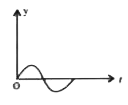If l1,l2,l3 are the lengths of the emitter, base and collector of a transistor then Solution in Kannada
l3<l2<l1
l1=l2=l3
l3>l1>l3
l3<l2<l2
The correct Answer is:C
In a transistor, the thinnest layer between two thick layers (emitter and collector) acts as the base.
∴l3>l1>l2 is correct out of the given alternatives.
Topper's Solved these Questions
Similar Questions
A balloon starts rising from thee ground with an acceleration of 1.25m/s2. After 8 s, a stone is released from the balloon. The stone will (taking g=10ms−2)
01:48View SolutionThe displacement time graph of a particle executing SHM is as shown in the figure. The corresponding force-time graph of the particle is-
 03:23View Solution
03:23View SolutionIf l_(1),l_(2),l_(3) are the lengths of the emitter, base and collector of a transistor then
05:12View SolutionFor a common base configuration of PNP transistor lClE=0.98, then maximum current gain in common emitter configuration will be
02:57View SolutionYou are given three lenses L_(1),L_(2) and L_(3) each of focal length 20 cm. An object is kept at 40 cm in front of L_(1), as shown. The final real image is formed at the focus 'I' of L_(3). Find the separations between L_(1),L_(2) and L_(3).
04:16View SolutionYou are given three lenses L_(1),L_(2) and L_(3) each of focal length 10 cm. An object is kept at 15 cm in front of L_(1), as shown. The final real image is formed at the focus 'T' of L_(3). Find the separations between L_(1),L_(2) and L_(3).
06:12View Solutionयदि l1,l2 तथा l3 किसी ट्रांजिस्टर की क्रमशः उत्सर्जक, आधार तथा संग्राहक की मोटाइयाँ है। तब -
01:49View SolutionLet L be the set of all straight lines in plane. l1 and l2 are two lines in the set. R1,R2 and R3 are defined relations.
(i) l1R1l2:l1 is parallel to l2
(ii) l1R2l2:l1 is perpendicular to l2
(iii) l1R3l2:l1 intersects l2
Then which of the following is true ?04:00View SolutionIf l1,l2 and l3 are the orders of the currents through our nerves, domestic appliances and average lightening, then the correct order of currents is
(1) l1>l2>l3 (2) l1>l3>l2
(3) l1<l2<l3 (4) l1=l2=l301:48View Solutionयदि L1,L2,L3.... स्वप्रेरकत्व की कुण्डलियाँ श्रेणीक्रम में जुडी है तो परिणामी स्वप्रेरकत्व
L=L1+L2+L3+...03:15View SolutionIf l1,l2,l3 are the lengths of the emitter, base and collector of a transistor then
04:42View SolutionThe distance between two points P and Q is d and the lengths of projections of PQ on the coordinate planes are l1,l2,l3 then l1+l22+l23d2
04:08View SolutionYour are given three lenses L1,L2 and L3 each of focal length 20cm. An object is kept at 40cm in front of L1 as shown. The final real image is formed at the focus I of L3. Find the separation between L1 and L2 and L3.
 03:48View Solution
03:48View SolutionYou are given three lenses L1,L2andL3 each of focal length 20 cm. An object is kept at 40 cm in front of L1, as shown. The final real image is formed at the focus 'I' of L3. Find the separations between L1,L2andL3.
 03:46View Solution
03:46View SolutionYou are given three lenses L_(1),L_(2) and L_(3) each of focal length 10 cm. An object is kept at 15 cm in front of L_(1), as shown. The final real image is formed at the focus 'T' of L_(3). Find the separations between L_(1),L_(2) and L_(3).
01:15View SolutionIf l,l1,l2andl3 be respectively the radii of the in-circle and the three escribed circles of a ΔABC, then find l1l2l3−l(l1l2+l2l3+l1l3).
02:05View Solution

